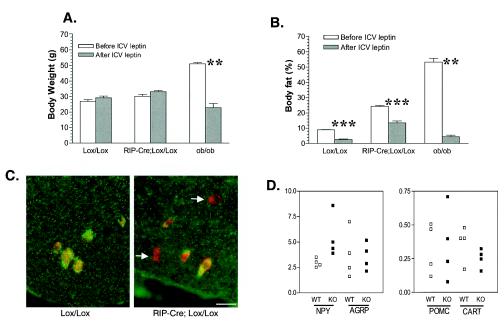FIG. 6.
RIP-Cre/STAT3lox/lox mice are resistant to central leptin action on adiposity. STAT3lox/lox mice (Lox/Lox), RIP-Cre/STAT3lox/lox mice (RIP-Cre/Lox/Lox), or ob/ob mice were infused with recombinant leptin into the third ventricle. Body weight (A) and body fat levels (B) before and after a 4-week leptin infusion are shown. ICV-administered leptin caused a reduction of body weight by more than half in ob/ob mice, and the percentage of body fat decreased to less than 5%, as determined by NMR. ICV-administered leptin has no appreciable effect on the body weight of 2-month-old STAT3lox/lox mice or RIP-Cre/STAT3lox/lox mice, but it does reduce the body fat of STAT3lox/lox mice to visually undetectable levels (data not shown), with a reading of less than 4% as determined by NMR. In contrast, RIP-Cre/STAT3lox/lox mice after 4 weeks of leptin infusion still have 13% body fat as determined by NMR. There were six mice per group for STAT3lox/lox mice or RIP-Cre/STAT3lox/lox mice; there were two ob/ob mice. **, P < 0.01; ***, P < 0.0001. (C) Deletion of STAT3 from OB-Rb-positive neurons. Sections were stained with a rabbit polyclonal antibody against OB-Rb (red) and a monoclonal antibody against STAT3 (green) and then superimposed. Arrows point to OB-Rb neurons (red) where STAT3 protein is absent. (D) Real-time PCR analysis of expression levels of NPY, AGRP, POMC, and CART. Expression levels are normalized to cyclophilin. There were four mice each for STAT3lox/lox mice (WT) and RIP-Cre/STAT3lox/lox mice (KO). Mice were 2 months old at the time of sacrifice.

